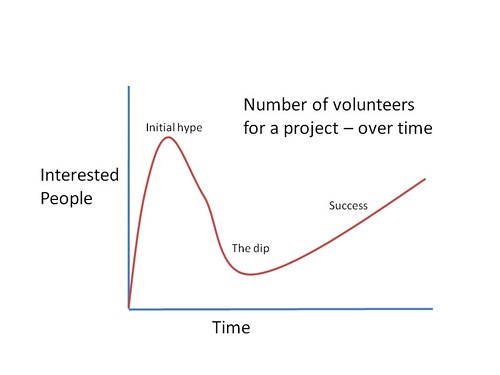(Update: This article was a PuneTech April Fools Prank. For a full apologyexplanation, see our article on 2 April.)
At PuneTech, one of the things that gives us pleasure is coming up with new ways in which this site can help the tech community in Pune. To quote Dhananjay Nene, we display a “willingness to experiment, learn and retry.” With this in mind, we are introducing a new feature that will help local small businesses, our readers, and us, all at the same time – Sponsored Posts on PuneTech – a win-win-win situation.
Of the 2 years we’ve been in existence, for 1-1/2 of them we’ve been refusing offers for paid advertisements and paid job postings on PuneTech because we don’t want to commercialize PuneTech. However, after receiving many impassioned pleas from small local startups, we have reached the conclusion that we have hit upon a major pain point, a desperate need that needs to be filled. Small startups cannot afford the normal PR and job posting channels and the future of Pune is suffering because of that. There is no good channel for small local companies to market themselves and get much needed visibility. Mainstream media is too big, too broad, and too expensive – and most importantly, generates very little long-term impact (or conversions).
After thinking over this problem for a long time, we have decided to allow commercial postings on PuneTech. We believe this is not really a reversal of our “not commercial” policy – is more of a social service.
With this in mind, we are introducing Sponsored Saturdays. Every Saturday, the PuneTech blog and front page will feature a paid article, which will either be a company profile written by the company itself, or a set of job postings by the company. The article will be clearly marked as a “Sponsored Post”. A flat price of Rs. 10,000 entitles a sponsor to post an article on the PuneTech blog on the next available Saturday slot. This will also be cross posted to twitter, the PuneTech linked-in group, and will go out in the PuneTech RSS Feed and to the e-mail subscribers. There will be no other posts on PuneTech for the next 48 hours – i.e. the sponsored post will stay on the front page until Monday morning. Single tweet postings may be purchased at Rs. 500 per tweet. We will consider special discounted rates for small and deserving companies who are not yet funded.
We are very pleased with the reactions we are getting from our early sponsors. Anup Tapadia, founder of of TouchMagix, who bought the first sponsored slot this Saturday, has high hopes from this program:
Through the normal channels, it is really difficult to find high quality programmers for the kind of cutting edge work we are doing in Pune. For example, a post on the standard job sites brings us hundreds of resumes, but not one of the candidates can answer basic computer science questions. Given the kind of readership PuneTech has, we are expecting to get some very good resumes.
Amit Kumar Singh, who plans on using this service to find customers for his software, says:
Finding the first few customers for a new product is the most difficult. And a sale to local customers will be much easier because the trust factor will be higher. All I’m expecting is 10 signups, and I’m sure word-of-mouth will take care of the rest.
Arun Prabhudesai of Trak.in commented:
All bloggers and mainstream media are doing this, either publicly or secretly. I don’t understand why you guys waited so long. But I’m glad you are finally doing it. Count me in.
For sponsoring a post, and for a copy of the detailed terms and conditions, please write to: sponsor@punetech.com. We do have some legal fine print, but the basic terms are these – the sponsored posts must be related to Pune, must be relevant to readers of PuneTech, and must adhere to the standards of quality of the rest of the PuneTech website. PuneTech reserves the right to refuse any sponsored post for any reason whatsoever, and the decision of the PuneTech editors if final.
We hope that many local companies take advantage of this opportunity.
Note: A majority of the PuneTech advisory board are in full support of our decision, and completely agree with us that this move will be welcomed by the tech community in Pune. In the interest of full transparency, we would like to disclose that two of our advisors who did not agree with this decision have resigned from the board. However, we are confident that after a few months of successfully running this program, we will be able to convince them to re-join.
We will continue to tweak and fine tune this program based on the response and feedback we receive. So please let us know your thoughts in the comments below. Thanks.
2nd April Update: As noted at the top, this article was an April Fools Day prank. To ensure that comments on this post did not give away the prank too early, all comments that mentioned “April Fools Day” were held in moderation until the end of the day. All these comments have now been approved, but we have prefixed these comments with a [***]. When reading the comments below, please note that all comments beginning with the [***] were not visible to anybody on 1st April.
![Reblog this post [with Zemanta]](http://img.zemanta.com/reblog_b.png?x-id=fb7fba18-4862-4db3-9b63-320aa2ec3046)
![Reblog this post [with Zemanta]](http://img.zemanta.com/reblog_b.png?x-id=32a3c41e-197a-45ad-91ad-844056c49061)

![Reblog this post [with Zemanta]](http://img.zemanta.com/reblog_b.png?x-id=9b9d6de0-0b08-44a9-b462-cd6e98108bf6)

![Reblog this post [with Zemanta]](http://img.zemanta.com/reblog_b.png?x-id=87bde1e3-3c9c-41b3-bd90-e8eb8145d3fc)
![Reblog this post [with Zemanta]](http://img.zemanta.com/reblog_b.png?x-id=c05dd354-33bb-4058-a31f-57c548632695)

